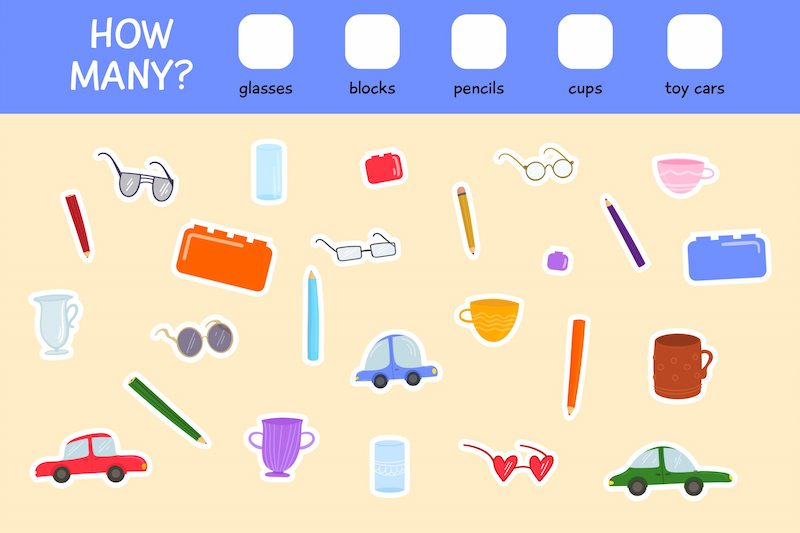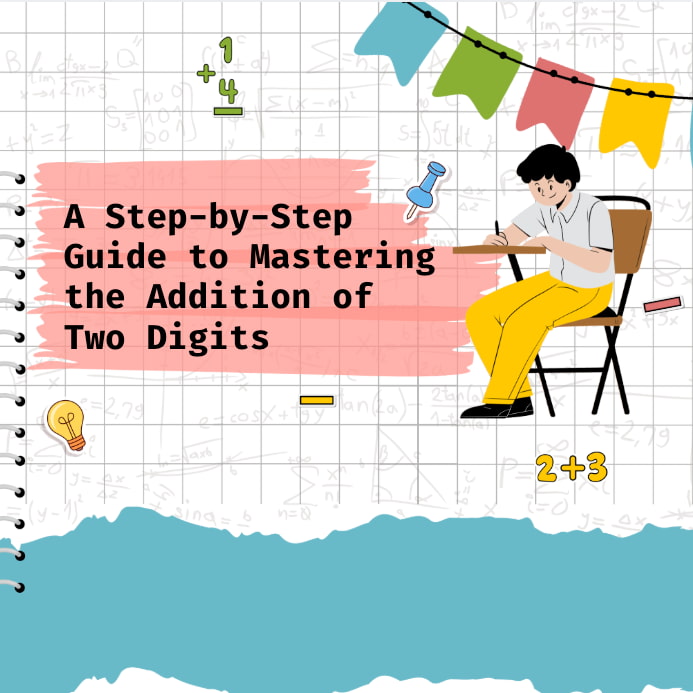Teaching math to preschoolers doesn’t have to be boring! With the right approach, learning numbers, counting, and shapes can be a fun and interactive experience. In this article, we’ll explore fun and educational math activities for preschoolers that encourage hands-on learning and problem-solving. At home or in the classroom, these activities will help young children develop essential math skills while having a great time. Let’s dive into some exciting ways to introduce math to little learners!
Math activities for preschoolers
Here are some fun and engaging math activities for preschoolers that make learning numbers, counting, and patterns exciting.
1. Counting with everyday objects

How to play:
- Gather a small group of objects (e.g., 10 blocks or 5 apples).
- You can try using this counting object worksheet to make this activity easier.
- Ask your child to count them out loud while touching each item.
- Mix up the objects and have them count again to reinforce number recognition.
- To make it more challenging, give them a specific number to count out (e.g., “Can you give me 3 crayons?”).
- Try simple addition or subtraction by adding or removing items and asking, “How many are there now?”
Why it works:
- Helps develop one-to-one correspondence, meaning kids understand that each object represents a number.
- Strengthens fine motor skills when picking up and organizing small objects.
- Encourages early problem-solving as they compare and group different amounts.
For more counting activities for preschoolers, check out this post!
2. Number hunt

How to play:
- Write numbers on sticky notes, index cards, or small pieces of paper (start with 1-10 for beginners).
- Hide the numbers around the room, in the yard, or even under household objects.
- Ask your child to search for the numbers one by one.
- As they find each number, have them say it out loud and place it in the correct order.
- For extra learning, ask them to match the number with that many objects (e.g., find 3 blocks for the number 3).
Why it works:
- Strengthens number recognition and sequencing skills.
- Encourages physical activity, keeping little ones engaged.
- Builds problem-solving skills as kids search for hidden numbers.
3. Shape sorting

How to play:
- Cut out different shapes from colored paper or use shape blocks.
- Mix them up and ask your child to sort them by shape.
- Name each shape as they sort (e.g., “This is a triangle! How many sides does it have?”).
- For extra learning, sort by color or size as well.
Why It Works:
- Builds shape recognition and categorization skills.
- Strengthens fine motor skills as kids handle and sort objects.
- Encourages critical thinking by grouping objects based on attributes.
4. DIY number puzzle

How to play:
- Write numbers on one side of an index card and draw corresponding dots or stickers on the other side.
- Cut each card in half in a fun zig-zag or puzzle shape.
- Mix up the pieces and have your child match the numbers to the correct quantity.
Why it works:
- Reinforces number recognition and counting skills.
- Encourages problem-solving with matching pieces.
- Improves hand-eye coordination as they fit pieces together.
5. Playdough numbers

How to play:
- Roll playdough into “snakes” and shape them into numbers.
- Use cookie cutters or stamps to imprint numbers into the dough.
- Create small playdough balls and count them out to match each number.
Why it works:
- Strengthens fine motor skills through squishing and rolling.
- Reinforces number recognition in a fun, tactile way.
- Encourages creativity while learning.
6. Hopscotch counting

How to play:
- Draw a hopscotch grid with numbers using chalk outside or tape indoors.
- Have your child hop through the numbers while counting aloud.
- For an extra challenge, ask them to only jump on even or odd numbers.
Why it works:
- Reinforces number sequencing through movement.
- Builds gross motor skills and coordination.
- Turns learning into an energetic physical activity.
7. Pattern Play

How to play:
- Gather items like beads, blocks, or stickers in different colors.
- Create a simple pattern (e.g., red-blue-red-blue) and ask your child to continue it.
- Increase difficulty by adding more colors or shapes.
Why it works:
- Builds pattern recognition, a key skill for math and logic.
- Strengthens critical thinking and problem-solving.
- Encourages creativity with different materials.
8. Ten frame fun

How to play:
- Draw a ten-frame grid (two rows of five squares).
- Give your child small objects like beans or pom-poms.
- Ask them to place objects in the squares to match a number (e.g., five objects for the number 5).
Why it works:
- Strengthens number sense and counting skills.
- Helps with early addition and subtraction concepts.
- Provides a visual aid for understanding numbers.
9. Dice games

How to play:
- Roll a dice and have your child count the dots.
- Ask them to find that many objects in the room.
- Play a game where they roll two dice and add the numbers together.
Why it works:
- Reinforces counting and addition.
- Encourages turn-taking and problem-solving.
- Adds a fun, game-like element to learning.
10. Measuring with hands and feet

How to play:
- Have your child measure household objects using their hands or feet.
- Compare sizes by asking, “Which is longer, the table or the chair?”
- Introduce a ruler or tape measure for extra learning.
Why it works:
- Builds early measurement skills.
- Encourages comparisons and logical thinking.
- Makes math relatable to real-world objects.
11. Snack time math

How to play:
- Count out crackers, grapes, or cereal pieces before eating.
- Group snacks into sets of 2s, 5s, or 10s.
- Practice simple subtraction by eating one and asking, “How many are left?”
Why it works:
- Makes math hands-on and practical.
- Reinforces counting and grouping.
- Turns everyday moments into learning opportunities.
12. Calendar counting

How to play:
- Show your child a calendar and count the days together.
- Ask them to find today’s date and talk about yesterday and tomorrow.
- Use stickers to mark special days and count down to events.
Why it works:
- Reinforces number recognition in a daily context.
- Builds an understanding of time and sequences.
- Encourages planning and organization skills.
13. Number fishing game

How to play:
- Cut out paper fish and write numbers on them.
- Attach a paperclip to each fish and use a magnet on a string as a fishing rod.
- Have your child “catch” a fish and call out the number.
Why it works:
- Strengthens number identification.
- Builds hand-eye coordination.
- Turns learning into an exciting game.
14. Sorting and classifying

How to play:
- Gather a mix of objects (buttons, blocks, coins).
- Ask your child to sort by color, size, or type.
- Talk about how they decided to group them.
Why it works:
- Develops categorization and logic skills.
- Encourages attention to detail.
- Strengthens problem-solving abilities.
15. Sticker graphing

How to play:
- Create a basic chart with columns for colors or favorite animals.
- Have your child place stickers in each category.
- Count and compare results.
Why it works:
- Teaches early data collection and organization.
- Reinforces counting and comparing.
- Introduces graphing in a simple, visual way.
16. Singing number songs

How to play:
- Sing classic counting songs like “Five Little Monkeys” or “Ten in the Bed.”
- Use fingers or objects to act out the numbers.
- Create your own silly number song!
Why it works:
- Reinforces counting in a fun way.
- Helps with memory and rhythm.
- Encourages active participation.
17. Building with blocks

How to play:
- Build towers with a certain number of blocks.
- Compare heights and count how many blocks are in each.
- Create patterns using different colored blocks.
Why it works:
- Develops counting and spatial awareness.
- Encourages problem-solving and creativity.
- Introduces early engineering concepts.
18. Number jump game

How to play:
- Write numbers on large pieces of paper and spread them on the floor.
- Call out a number and have your child jump to it.
- Add challenges like jumping on even numbers only or counting backward as they jump.
Why it works:
- Reinforces number recognition in a fun way.
- Builds gross motor skills and coordination.
- Makes learning interactive and engaging.
19. Money play

How to play:
- Use real or toy coins and bills for sorting and identifying.
- Set up a pretend store where your child can “buy” small toys or snacks.
- Teach basic concepts like “a nickel is worth 5 cents” and practice simple exchanges.
Why it works:
- Builds early math and money sense.
- Encourages role-playing and decision-making.
20. Outdoor nature counting

How to play:
- Ask your child to count things in nature, like birds, flowers, or leaves.
- Compare sizes, such as finding the biggest and smallest rocks.
- Create a simple tally chart to track what they find.
Why it works:
- Reinforces counting in a real-world setting.
- Encourages observation and exploration.
- Makes math an everyday experience.
FAQs
1. How do you teach math to preschoolers?
Teaching math to preschoolers should be fun, hands-on, and interactive. Here are some effective ways to introduce math concepts:
- Use everyday objects: Count toys, snacks, or household items.
- Play games: Hopscotch, dice games, and number hunts make learning exciting.
- Sing songs: Rhymes like “Five Little Ducks” reinforce counting.
- Incorporate art and crafts: Shape sorting, sticker graphs, and DIY number puzzles help with recognition.
- Encourage problem-solving: Ask questions like, “How many blocks do we need to make a tower taller than this one?”
2. Why are math activities important for preschoolers?
Math activities help young children build essential skills for future learning. Some key benefits include:
- Developing number sense: Understanding numbers and their relationships.
- Improving problem-solving: Activities like sorting and puzzles encourage logical thinking.
- Enhancing fine motor skills: Using playdough, counting small objects, and writing numbers strengthen hand coordination.
- Building confidence: Fun math experiences help children feel successful and excited about learning.
- Encouraging real-world connections: Counting snacks, measuring objects, and recognizing money teach math in a practical way.
Final thoughts
Math activities for preschoolers are a fun and engaging way to build essential early learning skills. By incorporating hands-on games, counting exercises, and interactive play, young children can develop number recognition, problem-solving abilities, and logical thinking in an enjoyable way. Start exploring these math activities for preschoolers today and watch your child’s love for numbers grow!








